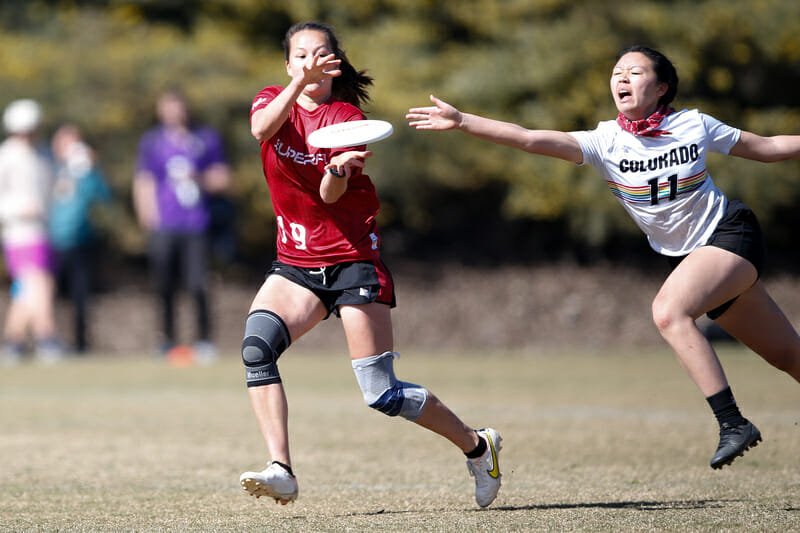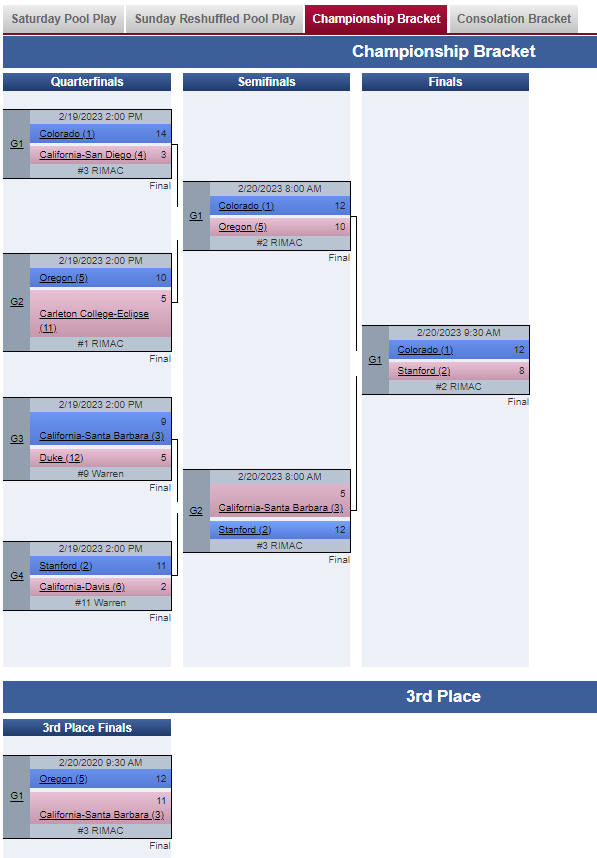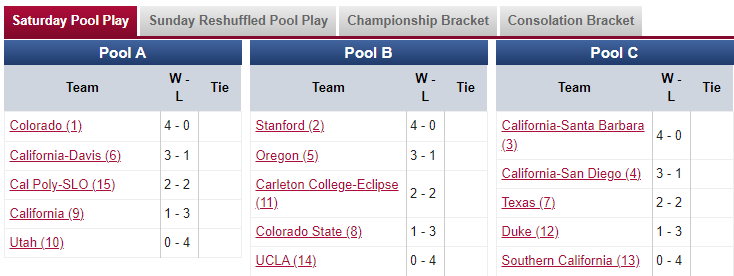Breaking down the Presidents' Day semifinalists, and other notables from a big three-day weekend in the women's division.
February 23, 2023 by Graham Gerhart in Recap with 0 comments

Ultiworld’s coverage of the 2023 college ultimate season is presented by Spin Ultimate; all opinions are those of the author(s). Find out how Spin can get you, and your team, looking your best this season.
The Presidents’ Day Invite has been a staple of the college division for over a decade now, and since it’s been going, it’s set a precedent for the rest of the season. Amassing wins in San Diego is often a strong sign of postseason success, especially with the level of competition the tournament provides. It’s also been almost entirely dominated by the Southwest — until this year. Not since 2015, when that Oregon team beat Stanford to take the tournament, have we seen a winner from outside of California.
Thankfully, Colorado bucked that trend and introduced some variance back to the tournament. Granted, Quandary were the favorites and their win over Stanford in the final was the predicted result. Looking at the results in context for the season, the bracket played out fairly close to expectations, with only a few anomalies on the way.
Colorado being good certainly isn’t the epiphany that most might have hoped to learn from the proceedings in La Jolla, but over the course of the weekend, and especially in the semis and final, there will be plenty to mull over until the next time we see all these teams in action.
Final Results



Quandary Solves the Enigma of the Stanford Defense
Consistency is the very antithesis of college ultimate. Thanks to the continual introduction of new players, new coaches, new schemes, and new opponents, consistency is an almost impossible goal in college ultimate. As a rule, variability abounds. Somehow, against all odds, Stanford Superfly stands in the face of that rule. Despite all the additional variables introduced every new season, Stanford has consistently been nationally competitive in the women’s division since Presidents’ Day became a relevant tournament for the bid picture.
This is mostly led by their efforts on defense. They work with what they have on offense year after year, but it’s their defense that produces results. If every player knows the fundamentals of their defense, they’re going to get the disc, and the offense can mostly fall into place after that, especially when they know the can get the disc back after a turn thanks to their defense.
So what was the difference-maker in the final for Colorado Quandary to beat a new iteration of an all-time defensive scheme? For a start, they didn’t let Stanford’s defense see the field all that much.
Quandary started on defense against Superfly, which allowed them to put the pressure on Stanford’s offense right out of the gate. That almost immediately translated into a Stacy Gaskill block on the high side of the field after only three passes from Stanford. Not long after that, Gaskill would get the bookends with a score at the back of the end zone. Not long after that, Colorado got another break chance on a run-through block from Saioa Lostra, which they converted after a layout from Faye Burdick. How do you stop the Stanford defense? Well, going up two breaks to start doesn’t hurt.
Their very next point was a table tennis match of missed opportunities from both sides as the clock continued to burn, but Stanford did get a previous hold, allowing them to send out their defense in a zone. Unsurprisingly, this led to a turn and a break, mostly thanks to the calm possession offense initiated by Superfly’s lefty handler Esther Filipek. Just like that, Stanford had tied the game at 2-2.
Still, Colorado wasn’t done forcing short turns. Every time the team was forced to play defense, they kept their opponents from gaining traction downfield, and clamped down on the reset handlers, forcing tough throws into the backfield for no gain and almost no momentum. Stanford was unable to generate much offense in these moments, and it led to Colorado reclaiming their two break lead for much of the first half.
It also helped that the Colorado offense was unintimidated against the many variations of the Stanford zone. With capable throwers in the backfield, Colorado’s handlers were content to swing the disc back and forth for a while as they identified the shape of the zone before trying to crack it open with a massive around flick or an inside shot through the cup. Every time Stanford lost the disc, they’d morph into zone formation, giving Colorado’s offense time to set themselves in the positions they wanted to attack without receiving too much pressure on their throwers. This showed itself on the ninth point of the game, where another short field turn from Stanford gave Colorado a chance to go up three breaks against their Californian competition, and Abbie Gillach lasered a flick through the cup, only to then receive the disc back moments later to launch a hammer over the top for the goal. Stanford’s zone didn’t scare Colorado, largely because it was clear that they were confident enough to beat it in multiple different ways.
That’s not to say that Colorado’s zone offense was perfect, but the tournament had given them plenty of practice against zones, even if they hadn’t worked on that at all before arriving in San Diego. “This was a good opportunity for us to set a foundation on zone work for us, it’s a working point for everybody,” said Colorado star Emma Cortright. “We haven’t worked on it for offense or defense yet.” No, Colorado’s zone offense wasn’t perfect, but it was good enough to stop Stanford from defaulting into zone at any chance they could, which was already a massive win for the team from Boulder.
This assurance in each other and their gameplan was largely the reason why they earned another two breaks to take half 8-3. Neither of the goals from those two breaks were the product of good system offense, but rather trust shots to two of Colorado’s most talented downfield players: Emma Cortright and Stacy Gaskill. Stanford had defenders within inches of the block both times, but Colorado’s trust in their cutters paid off.
The thing about Stanford, though, is that the same coaching that has kept this team relevant since the Jurassic era (shoutout to all of the Stanford players who were coached by Robin Knowler Davis and are now master’s eligible) can bring the entire weight of their experience to bear at halftime, helping the team lock back into focus.
Stanford in the first half and Stanford in the second half were night and day. Where once the team’s turns almost entirely stemmed from swings and forced upline throws, now they were getting the disc right to the end zone, allowing Macy Volbrecht and Filipek to win points with strike cuts or throws around the stack. They reformed their zone, forcing wide, difficult throws from Colorado and causing turns off of rushed shots. Perhaps most crucially, though, they covered the deep space well, forcing Colorado to find other ways of beating them than just trust shots to the end zone.
Even with all of this effort, Stanford was having a tough time stopping Colorado’s offense from converting. A lot of that can be attributed to the connection between Gaskill and Emma Williamson. There were multiple times where Gaskill would simply call for the deep shot, and Williamson would put it out for her. At 10-6, Stanford had a legitimate break chance, but a miscue returned to the disc to Quandary, only for Williamson to end up with the disc and throw a sitting backhand huck to Gaskill who was well marked by Filipek, just… taller. She plucked the disc out of the air without much difficulty, and Stanford lost their best chance for a break since the first half.
On Colorado’s next offensive point the wheels started to fall off a bit, as they chose huck after huck to try and close out the game, only for them all to fail. This gave Stanford plenty of chances that they couldn’t capitalize on, but showed a proof of concept where Superfly could try to build their way back into the game. Unfortunately, this point also was what firmly closed out the game in Colorado’s favor, as the extended duration of the possession battle ensured soft cap went on, and hard cap was soon to follow.
Neither team let off a break in the second half despite having more than a few chances, but the game really had been decided by Colorado’s players towards the end of the first half. “The momentum from the Oregon semis game gave us our lead over Stanford in the first half,” said Cortright. “We gained confidence from that, especially against zones.”
For Stanford, this is now their second time losing in heartbreaking fashion in their final game of the tournament, having suffered a similar result at SBI. How they measure up at their home tournament will be really telling, as the team will be hoping to avoid the ‘ever the bridesmaid, never the bride’ situation when it comes to the Southwest Triple Crown Tour. In the grand scheme of things, though, it’s quite an encouraging result for the squad. They only have lost to teams in the top 10 of the Power Rankings, and have won all the matchups they needed to as proof of concept. The team is already considerably better than they were in Santa Barbara, a sign that their development is going to be on a curve we might not see matched from any other team in the Southwest. “Even if we’re still in the part of the season where we’re working on the execution of our decisions, we want to push to the next step of the good decisions,” said Volbrecht. “That’s what we’ve realized over the course of the weekend.”
With Colorado, we already had a hunch this team was going to be every bit as competitive as they are, but it’s nice to see that they’re as good as advertised. Anyone watching them play would be able to tell that they have plenty of room for improvement, which is to be expected of any team at this point in the season, even if our expectations for them are higher than that of other teams. They aren’t winning a national championship with the team in its current state, but they don’t have to in February. Colorado knows how far they have to go and they’re working towards it with purpose. Their results right now are just the appetisers. May will be the main course.
Fugue Falls a Few Notes Short of a Symphony
With Colorado taking such a sizeable lead in the first half of the final, there’ll be some saying that their semifinal match vs. Oregon Fugue was the defacto final. While this almost entirely undersells how good Stanford had been up until that final, and how one bad half should not be indicative of any team’s merit, it is also entirely true that Oregon’s game with Colorado was perhaps the best game of the weekend.
Bonus Content for Presidents’ Day Invite 2023: Tournament Recap (Women’s) is only available to Ultiworld Subscribers
Already have a subscription? Log in
Whether you visit Ultiworld for our reporting, our podcasts, or our video coverage, you can help us continue to provide high quality content with a subscription. By becoming a subscriber, not only do you receive benefits like bonus content and full article RSS feeds, you also help fund all of Ultiworld's coverage in general. We appreciate your support!